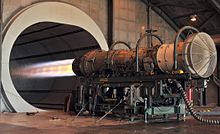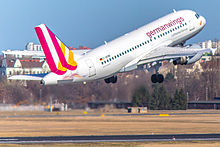
Back Straalmotor Afrikaans محرك نفاث Arabic المحرك النفاث ARZ Motor de reaición AST Reaktiv mühərrik Azerbaijani جت موتور AZB Турбореактивен двигател Bulgarian জেট ইঞ্জিন Bengali/Bangla Mlazni motor BS Motor de reacció Catalan
| Jet engine | |
|---|---|
 A Pratt & Whitney F100 turbofan engine for the F-15 Eagle being tested in the hush house at
Florida Air National Guard base | |
| Classification | Internal combustion engine |
| Industry | Aerospace |
| Application | Aviation |
| Fuel source | Jet fuel |
| Components | Dynamic compressor, Fan, Combustor, Turbine, Propelling nozzle |
| Inventor | John Barber, Frank Whittle, Hans von Ohain |
| Invented | 1791, 1928, 1935 |

A jet engine is a type of reaction engine, discharging a fast-moving jet of heated gas (usually air) that generates thrust by jet propulsion. While this broad definition may include rocket, water jet, and hybrid propulsion, the term jet engine typically refers to an internal combustion air-breathing jet engine such as a turbojet, turbofan, ramjet, pulse jet, or scramjet. In general, jet engines are internal combustion engines.
Air-breathing jet engines typically feature a rotating air compressor powered by a turbine, with the leftover power providing thrust through the propelling nozzle—this process is known as the Brayton thermodynamic cycle. Jet aircraft use such engines for long-distance travel. Early jet aircraft used turbojet engines that were relatively inefficient for subsonic flight. Most modern subsonic jet aircraft use more complex high-bypass turbofan engines. They give higher speed and greater fuel efficiency than piston and propeller aeroengines over long distances. A few air-breathing engines made for high-speed applications (ramjets and scramjets) use the ram effect of the vehicle's speed instead of a mechanical compressor.
The thrust of a typical jetliner engine went from 5,000 lbf (22 kN) (de Havilland Ghost turbojet) in the 1950s to 115,000 lbf (510 kN) (General Electric GE90 turbofan) in the 1990s, and their reliability went from 40 in-flight shutdowns per 100,000 engine flight hours to less than 1 per 100,000 in the late 1990s. This, combined with greatly decreased fuel consumption, permitted routine transatlantic flight by twin-engined airliners by the turn of the century, where previously a similar journey would have required multiple fuel stops.[1]
- ^ "Flight Operations Briefing Notes – Supplementary Techniques : Handling Engine Malfunctions" (PDF). Airbus. Archived from the original (PDF) on 2016-10-22.